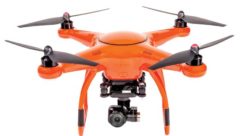Sensors are Your Friend
Apr 20, 1997 12:00 PM,
Howard E. Friedman
With new sensor technology and lower costs, security systems can protect premises better than ever before. Each year, the number of input devices for security systems increases as technology creates new sensing and measuring techniques – all while reducing device size and cost. It is now possible to protect premises far better than ever before.
Sensors and detectors range from simple mechanical and magnetic switches used to protect doors and windows to highly designed electronic sensors that can detect small concentrations of dangerous gas.
No matter what input device is in use, it behaves exactly like a simple on-off switch. (See Figure 1.) Some mechanical detectors actually contain a switch that changes state when the unit is violated. Other electronic detectors, such as motion detectors, glass-break sensors and smoke detectors, may switch states electronically or use a miniature relay to do so. In either case, it’s the opening or closing of the sensor’s internal circuit that triggers the alarm. Generally, intrusion devices are wired with the presumption that their switch is closed under normal conditions and will open once the sensor is violated. Fire sensors typically work in the opposite manner; their switch is open when the detector is not in alarm and will close when it is. (See Figure 2.)
Sensors are connected to the panel via a pair of wires, usually twisted, to provide some immunity to electromagnetic interference. At the end of the run, an end-of-line resistor (EOLR) is positioned. This circuit is known as a protective circuit or a protective loop. (See Figure 3.)
Each circuit contains one or more sensors. In the intrusion circuit, sensors are wired in series; in the fire circuit, they’re wired in parallel.
End-of-line resistorsIn both circuits shown in Figure 3, the presence of the EOLR affects the value of the current flowing. When either protective loop is operating with its detectors undisturbed, circuit current is a function of the applied voltage (usually 12 VDC), and the total circuit resistance, ignoring the small resistance presented by the wiring and the switches, is essentially that of the EOLR. In the burglar alarm circuit, it’s obvious that a break in the current flow, whether because of an intrusion or a disconnected wire, causes the current to fall to zero. This represents a fault, causing an alarm.
However, suppose that, because of a poorly placed staple, the conductors at point A touch. Basic electrical theory dictates that the sensors beyond point A – contacts two and three – would be shorted out and eliminated from the circuit – an unacceptable situation. It is because of this possibility that the EOLR is included. Because the short at A also bypasses the resistor, the loop current would rise and be detected by the panel’s internal electronics. Just like a break in the wiring, such a condition would be cause for a fault or a false alarm.
In the fire loop, the resistor provides the same three determinations. During normal operation, loop current is a function of the resistor; should a wire break, current falls to zero, generating a trouble condition. Unlike intrusion circuits, a wiring break in a fire circuit is not sufficient reason to blatantly cause an alarm, which might ultimately involve the fire department; instead, a trouble signal, audible at the premises and reportable to the monitoring station, is used under such conditions.
If an actual fire were to occur, one or more of the detectors on the fire circuit would trip, closing the internal switches and shorting the loop. As with the intrusion circuit, the current increases, sounding an alarm immediately. Remember, unlike burglar alarms, fire alarms are always armed and are able to alarm at any time. It’s unlikely a short-circuit would ever occur in the fire alarm wiring because fire wire is usually sheathed and well-protected, unlike the twisted pair commonly used for intrusion sensors. Nonetheless, an errant staple has been known to cause all kinds of problems.
Think of the end-of-line resistor as a means for providing supervision for each of these circuits and their wiring. In the case of fire loops, the resistor allows the panel to distinguish between a trouble condition (an open wire) and an alarm (a short circuit).
In Figure 3, each protective circuit is referred to as a zone. At an installation site, zones relate to specific protected areas and use one or more sensors to provide such protection. Table 2 shows how some typical zone (i.e. protective circuit) assignments might be made in both a residential and a modest commercial setting.
Large installationsMost alarm control panels have about 12 zones. If the panel supports both intrusion and fire functions, it should be more than adequate for most residential and small commercial applications. But when the demands of the job require several dozen (or more) contacts and sensors, as in a luxury home or a medium-to-large commercial building, the 12-zone panel simply won’t do.
It’s not unreasonable to ask why you can’t put a lot of sensors on the same zone. Zones are nothing more than series or parallel circuits. Although that’s true, that approach has two problems. The first lies in the area of convenience and identification. Suppose we applied our 12-zone panel to a large installation. To do so, we might have to wire each zone with five or six detection devices, with the zone spanning two or more separate areas. If a fault were to occur on that zone, it would be difficult to correct because the alarm system can only identify the violated zone, not the faulted contact on that zone. Any of the contacts could be responsible. Also, it’s bad practice to have a small panel support a large installation because of power requirements. As you add motion and smoke detectors and other sensors requiring power, you might exceed the current capabilities of a 12-zone panel.
Bigger installations – those with hundreds of zones – are quite common and are performed every day. The secret? Multiplexing.
Multiplexing takes advantage of the advances made in low-cost digital electronics. The term multiplexing means “many into one.” The cable that brings television shows into your home is a perfect example of multiplexing because it carries dozens of programs simultaneously. The telephone network carries many concurrent conversations over a single wire or fiber-optic run, and most FM radio stations use multiplexing to carry two stereophonic sound channels over a single broadcast frequency. To achieve the benefits of a multizone panel in a relatively inexpensive package, several manufacturers have added a single multiplexed loop to their 12-zone controls. (See Figure 4.)
Depending on the panel, it takes little more than one second for the control to poll all of its multiplexed devices and log their responses. This allows the control to tell which are secure and which are faulted; this information is then displayed on each of the system’s keypads to inform the user.
If an alarm were to occur, the sensor involved would generate its alarm asynchronously; it wouldn’t wait for a polling signal to reply. At best, this process only saves about a second, but because it’s technically possible, it’s done.
Multiplexing also allows for the detection of wiring breaks. Suppose, in Figure 4, that a wire at point A were to break. Sensors with addresses 21, 22 and 23 would be unable to receive the polling signals and, of course, would never reply to them. After trying several times to get a response from the affected sensors, the panel would register a trouble condition and where it might be located. Similarly, if the multiplex loop should accidentally short circuit, the entire loop would be rendered ineffective and would be so noted by the panel. Although some multiplexed systems use four wires per detector, the end result is still better than running wires to individual zone terminations on the panel.
Off, away, homeWe’ve learned that an alarm system’s environmental and medical protection components are always armed and can never be turned off. Also, some 24-hour intrusion devices, such as the sensors used on window glass or the tamper switches protecting the panel and sounder housings, cannot be disarmed.
Obviously, though, certain areas must be armed or disarmed based on use. As such, several modes of intrusion system operations are available to suit the homeowner or commercial user. Let’s use a residential system as an example, and the designations of “off, away and home” to describe them.
In terms of intrusion components, a system in the “off” mode disarms all non-24-hour protection devices and permits easy entry and exit of the premises as well as a complete range of motion within. In the “away” mode, all detectors are armed, and any violation results in an immediate alarm, except for violations on zones designated for entry and exit, which permits the user to enter without causing an alarm. If such a zone is violated during the “away” mode, it causes a delayed alarm accompanied by a pre-alarm noise, such as a warning tone from the keypad reminding the user entering the premises to disarm the system. If that’s not done within a specified and programmable time interval, the full alarm sounds.
The “home” mode is exactly like the “away” mode, except that all interior motion detector zones are bypassed, permitting easy movement within the premises while the perimeter remains protected. Another mode of operation, sometimes called the “night” mode, may be available. It’s identical to the “home” mode except, to provide additional security, a violation of an entry-exit zone causes an immediate alarm; this prevents an intruder entering through the front door from taking advantage of the entry delay. Table 3 summarizes these modes of operation.
Programming sensors of all typesDuring the panel’s programming, the characteristics of each sensor are stored in an electronic database, no matter whether the sensor is on a standard EOLR zone or on a multiplexed circuit. Included in such information is the sensor’s zone number and its function or type in the system.
For example, if zone 1 were programmed as a front door entry-exit contact, the panel knows that if zone 1 were violated during the armed period, an entry delay must be provided and – unless the panel were disarmed within the specified delay interval – it must sound an intrusion alarm. If zone 2 were programmed as an interior motion detector, the panel would know to sound an instant alarm if the detector were violated during the armed period; it would also know to ignore violations from the PIR if the system were set to “home.” If zone 3 were programmed for fire detection, a violation at any time would cause an immediate alarm.
Sounding and signaling devicesBells and sirens are the primary means of signaling alarms, and many types of each are available. Depending on the volume or the type of sound required, it may be desirable or even necessary to produce it electronically; synthesized sound has become quite popular. Today, electronic sirens can be made to sound like bells, horns or buzzers and can even announce spoken messages in different languages. Sounders used for commercial fire applications are more closely regulated and, unlike the sounders used in intrusion systems, might have to be supervised, if required by local fire codes. (See Figure 5.)
As with any trade or discipline, alarm system theory and installation has a lot to it. If you want to know more about alarm systems or their installation, contact the NBFAA and the NFPA at the following addresses:
* National Burglar and Fire Alarm Association (NBFAA), 7101 Wisconsin Ave., Suite 901, Bethesda, MD 20814; 202-362-7455.
* National Fire Prevention Association (NFPA), 1 Batterymarch Park, Quincy, MA 02269; 617-984-7274.










